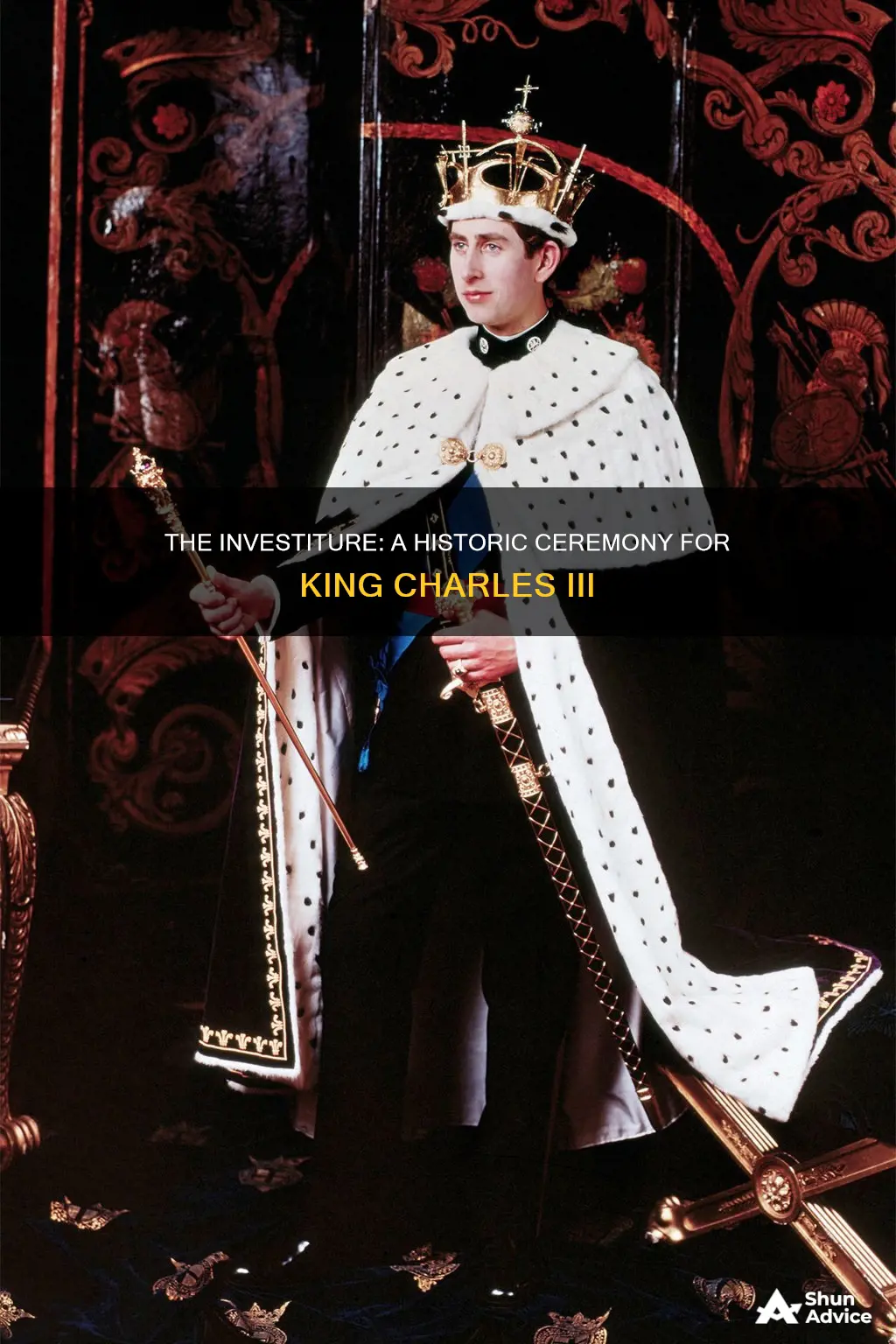
King Charles III ascended to the throne and was proclaimed the monarch of the United Kingdom immediately after the death of his mother, Queen Elizabeth II, in September 2022. He was formally crowned at Westminster Abbey on 6 May 2023.
Charles was the longest-serving Prince of Wales in British history before he became king. He was invested as the Prince of Wales in a ceremony at Caernarfon Castle in 1969.
| Characteristics | Values |
|---|---|
| Date of Accession | 8 September 2022 |
| Age at Accession | 73 |
| Coronation Date | 6 May 2023 |
| Coronation Location | Westminster Abbey |
| Coronation Guests | 2,000 |
| Coronation Crown | St Edward's Crown |
| Coronation Oath | To uphold the constitutional government and preserve the Church of Scotland |
What You'll Learn

Charles became king immediately after his mother's death
On 8 September 2022, Queen Elizabeth II died at the age of 96. Her son, Charles, became King Charles III the moment his mother died.
Charles was 73 years old when he became king, making him the oldest person to accede to the British throne. He was also the longest-serving heir apparent and Prince of Wales in British history.
Charles was proclaimed king by the Accession Council, a ceremonial body made up of members of the Privy Council, at St James's Palace in London. The proclamation was then signed by senior figures, including the prime minister, the Archbishop of Canterbury, and the Lord Chancellor. The proclamation was also read out in Edinburgh, Cardiff, and Belfast, as well as in other locations across the United Kingdom and the Commonwealth.
Charles's coronation took place at Westminster Abbey on 6 May 2023, almost eight months after he became king. The coronation was a religious Anglican service, carried out by the Archbishop of Canterbury. During the ceremony, Charles took the Coronation Oath, was anointed with holy oil, and received the orb and sceptre as symbols of his new role.
As king, Charles has continued to carry out official duties and engagements. He has also maintained his interest in environmental issues, architecture, and alternative medicine. In addition, he has expressed his desire to be seen as a "defender of faith," promoting religious tolerance and interfaith dialogue.
Charles's reign has seen significant events, including his cancer diagnosis in 2024, which led to the temporary suspension of some public engagements. He has also faced criticism for his response to the press and for his involvement in various controversies, including cash-for-honours allegations linked to his charities.
Despite some challenges, Charles has received support from a significant portion of the British public, with an approval rating of 58% as of May 2024.
AGNC Investment Dividends: Payout Patterns and Frequency
You may want to see also

The Accession Council proclaimed Charles king at St James's Palace
The Accession Council is a group of advisors to the sovereign, known as the Privy Council. It is made up of members of the Privy Council, which includes senior MPs, past and present, and peers, as well as senior civil servants, Commonwealth high commissioners, and the Lord Mayor of London.
The ceremony included a series of prayers and pledges, commending the previous monarch and pledging support for the new one. The proclamation was then signed by senior figures, including the prime minister, the Archbishop of Canterbury, and the Lord Chancellor. It was read aloud from a balcony above Friary Court in St James's Palace, and for the first time since 1952, the national anthem was played with the words "God Save the King".
This was not a "swearing-in" ceremony, as is sometimes seen with other heads of state. Instead, the King made a declaration to uphold the constitutional government and, in line with tradition dating from the early 18th century, he made an oath to preserve the Church of Scotland.
Retirement Reinvented: Exploring Post-Retirement Investment Opportunities
You may want to see also

Charles took an oath to preserve the Church of Scotland
King Charles III's first act after being officially proclaimed King was to sign an oath to preserve the Church of Scotland. This took place at an Accession Council meeting at St James's Palace in London, where the King was formally proclaimed monarch. The meeting was attended by the Queen Consort, the new Prince of Wales, Prince William, and around 200 members of the Privy Council.
The King swore:
> "I, Charles III by the Grace of God of the United Kingdom of Great Britain and Northern Ireland and of My other Realms and Territories King, Defender of the Faith, do faithfully promise and swear that I shall inviolably maintain and preserve the Settlement of the true Protestant Religion as established by the Laws made in Scotland in prosecution of the Claim of Right and particularly by an Act intituled 'An Act for securing the Protestant Religion and Presbyterian Church Government' and by the Acts passed in the Parliament of both Kingdoms for Union of the two Kingdoms, together with the Government, Worship, Discipline, Rights and Privileges of the Church of Scotland. So help me God."
This oath reflects the constitutional independence of the Church of Scotland from the state. The Church of Scotland is a Presbyterian church and recognises only Jesus Christ as 'Head of the Church'. Therefore, when King Charles attends church services in Scotland, he does so as an ordinary member of the congregation.
The duty to preserve the Protestant religion in Scotland was affirmed in the 1707 Act of Union between England and Scotland. This act established one "Parliament of Great Britain" to rule over both kingdoms, but it also hard-wired the continued independence of the Presbyterian Church of Scotland. As a result, British monarchs swear to uphold the Protestant religion in Scotland and maintain the Presbyterian Church Government.
The complexity of this situation can be traced back to the 16th and 17th centuries, when Scotland was a separate country with its own institutions and identity. Even after the Union of the Crowns in 1603, Scotland remained a separate kingdom, sharing a monarch with England and Ireland. In the 1630s, Charles I and the Archbishop of Canterbury, William Laud, attempted to force the Church of Scotland to use the Book of Common Prayer, which was resisted in an armed insurrection. This led to the 'Bishops' Wars', which Charles I lost, and he was forced to accept that the Scottish Church would be different from the Church of England.
Water Rights: An Investment Guide
You may want to see also

Charles was crowned at Westminster Abbey on 6 May 2023
On 6 May 2023, King Charles III was crowned at Westminster Abbey. The coronation was a grand ceremony, steeped in tradition and symbolism, marking the official recognition of Charles as the monarch. The date was carefully chosen, almost eight months after the King's Proclamation, to allow for a period of mourning following the death of Queen Elizabeth II.
The coronation of King Charles III was an Anglican religious service, conducted by the Archbishop of Canterbury. It was attended by around 2,000 guests and broadcast to the world. The ceremony included a series of rituals and pledges, such as the anointing of the King with oils of orange, roses, cinnamon, musk, and ambergris. The King also received symbolic regalia, including the orb and sceptre, before the Archbishop of Canterbury placed the St Edward's Crown upon his head.
St Edward's Crown is a solid gold crown dating back to 1661 and weighing a hefty 2.23kg. It is usually kept at the Tower of London with the Crown Jewels and is only worn by the monarch during the coronation itself. The coronation ceremony also saw Queen Camilla crowned, as she became the Queen Consort.
The coronation of King Charles III was a significant event in British history, marking the formal investiture of the new monarch. It was a moment of transition and continuity, honouring the legacy of Queen Elizabeth II while ushering in a new era under King Charles III. The coronation ceremony has been a tradition for the last 900 years, with Westminster Abbey being the site of coronations since William the Conqueror.
The coronation of King Charles III was not just a national event but also an occasion of international significance. As the head of the Commonwealth, King Charles III is recognised in 56 independent countries with a population of 2.5 billion people. The coronation ceremony reflected the diversity and inclusivity that the King wishes to promote during his reign.
Pay Off the House or Invest: Where Should Your Money Go?
You may want to see also

Charles is the oldest person to ascend the British throne
On 8 September 2022, Queen Elizabeth II died at the age of 96. Her eldest son, Charles, became King Charles III the moment his mother died. At 73, Charles is the oldest person in British history to ascend the throne.
Charles was born at Buckingham Palace on 14 November 1948. He was 4 years old when his mother was crowned Queen. He is the first new King Britain has had in 70 years. The previous oldest King to ascend the throne was King William IV, who was 64 when he was crowned in 1830.
Charles is also the longest-waiting heir apparent. Unlike his mother, who became Queen at 25, Charles has spent his entire life in preparation to wear the crown. Elizabeth II lived to be 96 years old, and was the longest-reigning British monarch.
Charles was officially proclaimed King on the Saturday following the Queen's death. This event took place at St James's Palace in London, in front of a ceremonial body known as the Accession Council. It included a series of prayers and pledges, commending the previous monarch and pledging support for the new one. The proclamation was then signed by senior figures, including the Prime Minister and the Archbishop of Canterbury.
The symbolic high point of the accession was the Coronation, when Charles was formally crowned. This took place almost eight months after the King's Proclamation, on 6 May 2023. The ceremony was held at Westminster Abbey, where coronations have been held for the last 900 years. It was conducted by the Archbishop of Canterbury, and the King took the Coronation oath in front of the watching world. During this elaborate ceremony, he was anointed using oils of orange, roses, cinnamon, musk and ambergris. He received the orb and sceptre as symbols of his new role, and the Archbishop placed the solid gold St Edward's Crown on his head.
Warehouses: An Overlooked Investment Haven
You may want to see also
Frequently asked questions
Charles became king immediately upon the death of his mother, Queen Elizabeth II, on September 8, 2022.
The ceremony to proclaim Charles as king is called the Accession Council.
The Accession Council took place at St. James's Palace in London.
The Accession Council was made up of members of the Privy Council, senior MPs, civil servants, Commonwealth high commissioners, and the Lord Mayor of London. There were a series of prayers and pledges, and the new king took an oath to preserve the Church of Scotland.
Charles was crowned king on May 6, 2023, at Westminster Abbey.







